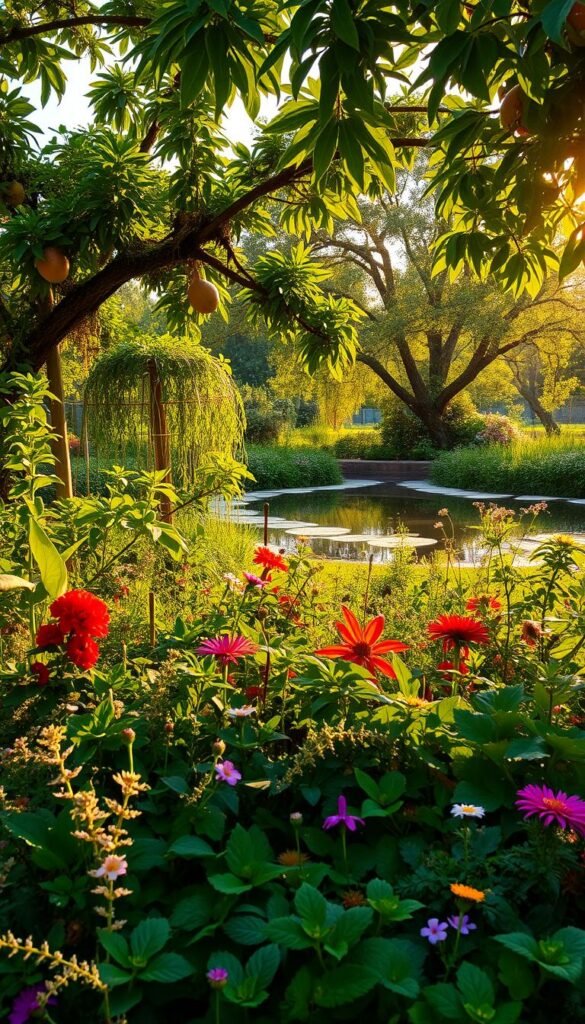Imagine growing fresh produce while restoring nature’s balance right outside your door. This is the promise of ecological gardening methods that work with the land instead of against it. By mimicking natural woodlands, these systems produce abundant harvests while creating habitats for pollinators, birds, and beneficial insects.
Experts with decades of experience have proven these approaches can thrive in spaces as small as apartment balconies. Unlike traditional plots requiring constant upkeep, layered plant communities become more resilient and productive each year. Seattle’s Beacon Hill project, for example, now yields over 5,000 pounds of fruit annually while supporting 60% more pollinators than conventional gardens.
You’ll discover how these ecosystems provide far more than just nourishment. They capture carbon, rebuild soil health, and even reduce urban heat through strategic plant placement. Whether you’re growing figs on a fire escape or walnuts in a backyard, the principles remain the same: diversity creates stability.
Ready to start your journey? Our guide to designing a permaculture food forest breaks down everything from selecting native species to arranging plant layers. Let’s explore how you can turn any space into a living pantry that gives back to the earth.
Understanding Self-Sustaining Garden Models: An Overview
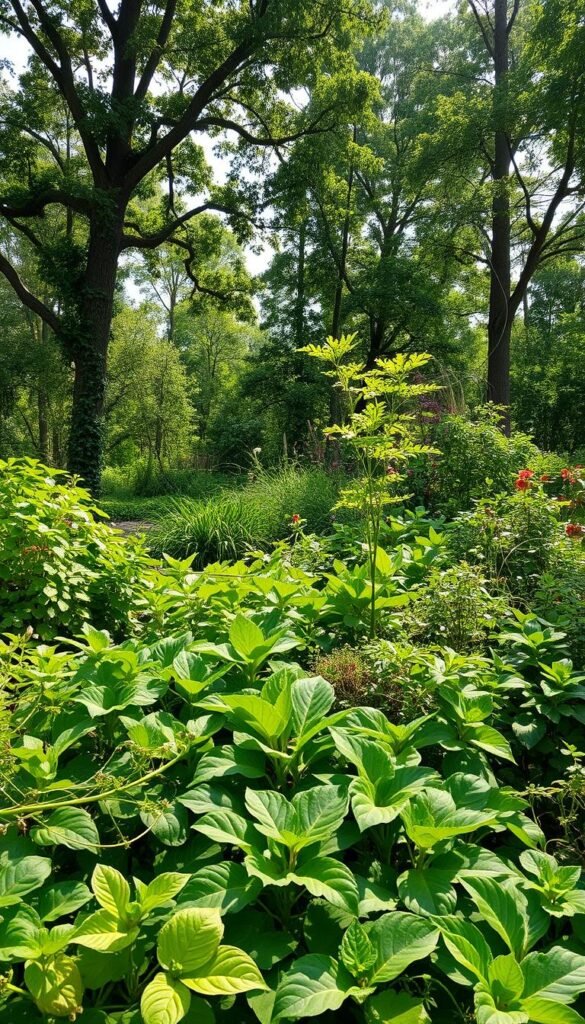
Picture a landscape where plants work together like puzzle pieces, building their own nutrients and shelter. These edible forest designs copy nature’s patterns to grow fruits, nuts, and herbs with minimal effort. Unlike single-crop plots, they layer trees, shrubs, and ground covers to form living networks that feed both people and wildlife.
At their core, these systems solve three big challenges: fertility, water, and pests. Deep-rooted plants mine minerals from subsoil, while nitrogen-fixers like clover feed neighboring crops. Rainwater gets captured by swales or mulch instead of running off, and predator insects handle aphids naturally. “You’re not just growing food,” one urban farmer notes, “you’re building relationships between species.”
From balcony containers to acre-wide food forest projects, these models adapt to any space. A Chicago community transformed vacant lots into berry-producing groves, while Arizona residents grow desert-adapted mesquite and prickly pear. What unites them? They prioritize abundance through diversity – stacking plants vertically to maximize yields without chemicals.
Beyond fresh produce, these permaculture gardening design principles strengthen food security. They buffer against drought, reduce grocery costs by up to 40%, and boost property values through lush greenery. Even better: every apple tree or comfrey patch becomes a carbon-absorbing ally in fighting climate change.
Whether you’re planting a windowsill herb spiral or a backyard edible forest, success starts with observing nature’s wisdom. Start small, mimic local ecosystems, and let the garden evolve into a self-fueling haven.
Exploring the Principles of Permaculture and Natural Ecosystems
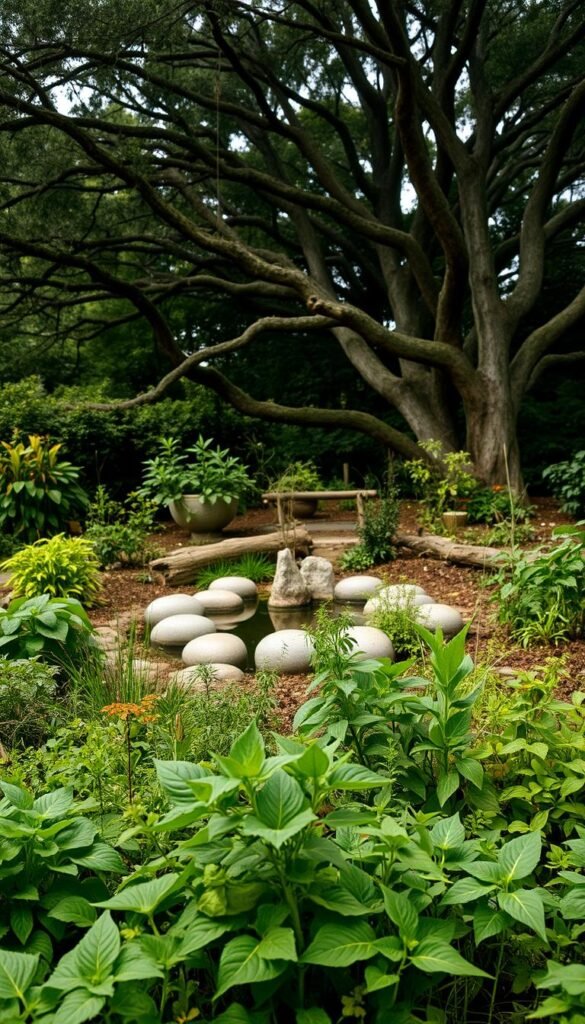
Consider a garden that mirrors the resilience of untouched wilderness. This approach roots itself in three ethical pillars: caring for the earth, supporting communities, and sharing surplus resources. These ideas form the backbone of regenerative growing systems that heal landscapes while feeding families.
Key Permaculture Ethics and Principles
Every decision starts with Earth Care—nurturing soil, conserving water, and protecting biodiversity. People Care means designing spaces that meet human needs without exploitation. Fair Share challenges us to redistribute excess yields, whether sharing harvests or returning nutrients to the land.
The twelve guiding principles turn ethics into action. Observe how sunlight moves across your space before planting. Capture rainwater in swales or barrels. Use apple branches as natural trellises instead of buying stakes. “Work smarter, not harder,” says permaculture designer Lauren Wilson. “Let nature’s patterns guide your hands.”
How Natural Ecosystems Inspire Your Design
Mature woodlands show how balanced systems thrive. Tall trees shelter berry bushes, while ground covers suppress weeds. Fungi networks connect roots, sharing nutrients between oaks and mushrooms. Your garden can replicate these partnerships—pair nitrogen-fixing peas with hungry corn plants, or let ladybugs patrol your roses.
Notice how wild areas progress from quick-growing pioneers to long-lived species. Mimic this succession by planting fast-growing annuals while fruit trees establish. Your space becomes a living blueprint, evolving toward stability through strategic plant alliances. Start by studying local meadows or forests—they’ll reveal what grows best in your climate.
Self-Sustaining Garden Models: Food Forests and Permaculture Basics
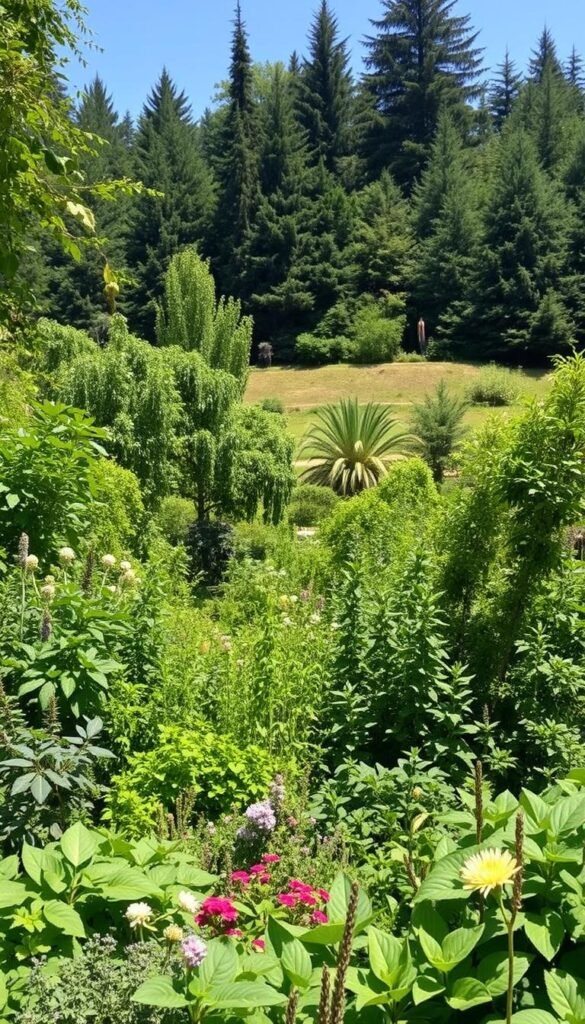
Think of a space where every plant serves multiple roles—feeding you while supporting other species. These multi-level growing areas stack trees, shrubs, and ground covers into thriving communities. Unlike single-crop fields, they create habitats for bees, birds, and soil microbes through strategic partnerships.
- Tall canopy trees provide shade for delicate plants
- Mid-level shrubs yield berries and medicinal leaves
- Ground covers suppress weeds and retain moisture
Urban spaces shine with compact versions. Balcony growers use dwarf citrus trees paired with trailing nasturtiums, while rooftop setups combine columnar apples with vertical herb towers. A Phoenix resident transformed their 1/10-acre lot into a desert oasis using drought-resistant mesquite and cholla cactus.
| Feature | Traditional Garden | Layered System |
|---|---|---|
| Annual Yield | 2-3 crops | Year-round harvests |
| Maintenance | Weekly upkeep | Seasonal adjustments |
| Wildlife Support | Limited | 50+ species |
| Space Efficiency | Single plane | 7 vertical layers |
These plant networks grow stronger over time. Seattle’s Beacon forest project saw yields triple in five years as root systems deepened. By designing layered plant systems, you create living pantries that outlast seasonal changes. They withstand droughts better than lawns and rebound faster after extreme weather.
Beyond fresh produce, these spaces become community hubs. Australian growers host mushroom-foraging tours, while Spanish cooperatives sell jams from their shared edible forest. Your plot could yield not just meals, but workshops or native plant nurseries—turning ecological care into economic opportunity.
Designing Your Food Forest: From Concept to Layout
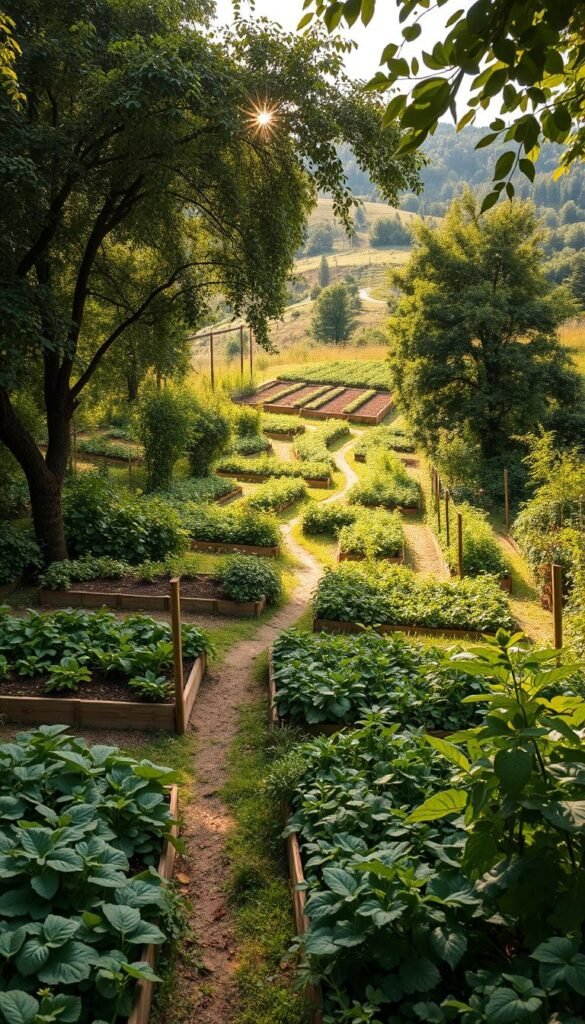
Transform your backyard into a living blueprint that evolves with nature’s rhythms. Successful food forest design balances practicality with ecological harmony, using four primary layout approaches. Renowned expert Martin Crawford emphasizes mid-to-late succession woodlands for their productivity, though urban spaces might favor compact orchard-style arrangements.
Mapping Your Site and Creating a Vision
Start by sketching your space’s sun patterns, slopes, and water flow. Track where shadows fall at different times and note areas that stay moist or dry. Crawford advises: “Your best teachers are the plants already thriving there – they reveal your soil’s secrets.”
Ask yourself:
- Do you want low-maintenance snacks or market-ready yields?
- Should paths accommodate wheelbarrows or quiet meditation?
- Which native species support local pollinators?
Selecting a Layout That Fits Your Space
Choose from these ecosystem-inspired designs:
| Layout Type | Best For | Key Feature |
|---|---|---|
| Savanna Systems | Large properties | Grazing areas + tree crops |
| Orchard Style | Commercial yields | Evenly spaced fruit trees |
| Woodland Pattern | Biodiversity | 7-layer plant stacking |
| Closed Canopy | Mature forests | Shade-tolerant species |
Urban growers often blend styles – dwarf trees underplanted with herbs work wonders on patios. Phase your planting over 3-5 years, starting with nitrogen-fixing shrubs to prep the soil. Remember: good design leaves room for nature’s surprises.
Choosing the Perfect Location and Conducting a Site Survey
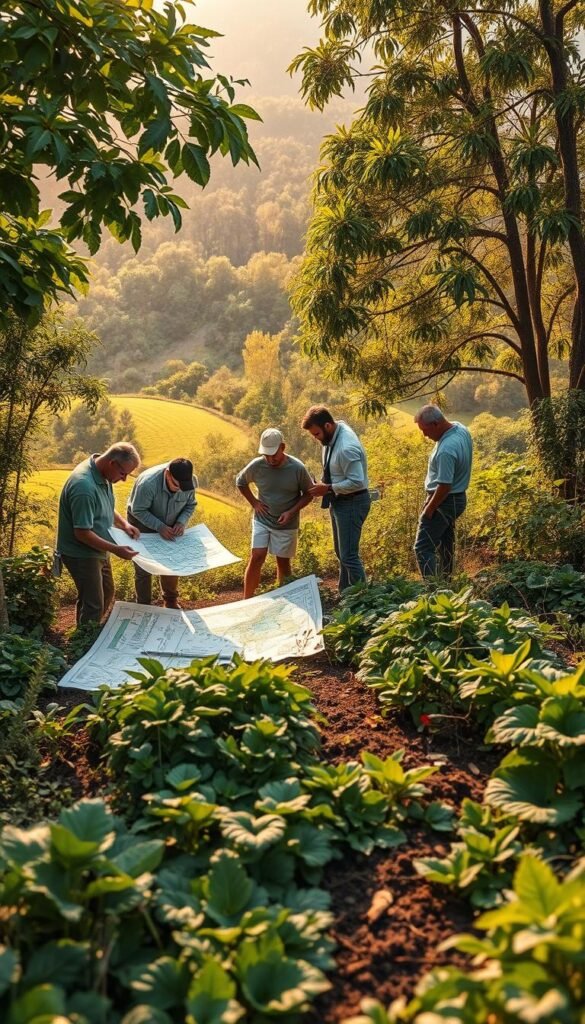
Your land’s unique personality holds the blueprint for successful plant partnerships. Start by digging into its hidden stories—how water moves after storms, where frost lingers longest, and which spots bake in summer sun. These clues determine whether pawpaws or persimmons will thrive.
Observing Local Ecosystems for Inspiration
Walk through nearby woodlands with fresh eyes. Notice how serviceberries cluster near streams or how hazelnuts flourish on slopes. “Your best plant list grows at your feet,” says ecological designer Marcus de la Fontaine. “Native species like elderberry and hawthorn reveal what your soil wants to grow.”
Conduct these field tests to match plants to your site conditions:
- Dig 12-inch holes to check drainage—fill with water and time how fast it disappears
- Track sunlight patterns using smartphone apps like Sun Surveyor
- Collect soil samples from different zones for pH and texture analysis
Create a microclimate map by noting:
| Zone | Features | Plant Matches |
|---|---|---|
| Sun traps | South-facing walls | Figs, rosemary |
| Boggy areas | Poor drainage | Willows, mint |
| Wind tunnels | Consistent airflow | Sea buckthorn, juniper |
Collaborate with neighbors through community growing projects to share soil data and swap climate observations. Document findings in a seasonal journal—this living record becomes your roadmap for planting success.
Integrating Plant Guilds and Layered Ecosystem Strategies
Envision a living tapestry where plants support each other across seven levels. This vertical strategy transforms any space into a thriving ecosystem that feeds both people and wildlife. Let’s explore how to craft these productive layers.
Establishing Your Garden’s Framework
Start with tall canopy layer trees like pecans or apples—they create shade patterns guiding your entire design. Underplant with dwarf cherries or hazelnuts in the subcanopy, ensuring sunlight filters through to lower levels.
Cultivating Middle Ground
The shrub layer bursts with blueberries, rosemary, and flowering currants. These plants attract pollinators while yielding snacks and medicines. Cluster them near paths for easy harvesting.
Finishing Touches Below
Creeping thyme and strawberries form a living ground cover layer, suppressing weeds and retaining moisture. Their roots intertwine with garlic and radishes underground, creating nutrient highways.
These layers work like nature’s orchestra—each plant playing multiple roles. Vining beans climb corn stalks, while comfrey leaves mulch nearby herbs. Over time, your layered ecosystem becomes its own maintenance crew, needing less work as connections deepen.

